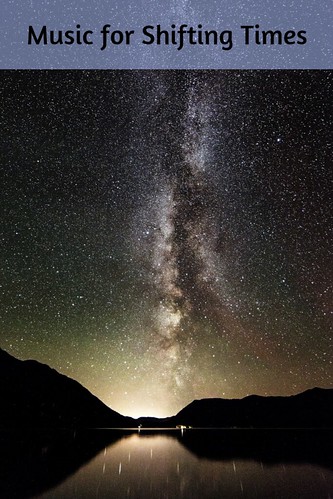Connection with place, with landscape, with well-loved and familiar things often comes with connection with each other. That's an idea we've explored from several perspectives in this series. In shifting times, physical place, whether you are present geographically or you are visiting through imagination or through memory, can offer a sense of comfort, of connection, of hope.

Landscape and geography are also endless sources of inspiration for musicians. Come with us for this part of the journey as we visit a history-filled road in Mississippi, explore a place where mountain meets sea in Atlantic Canada, take a look at rocks in Indiana, and learn what a composer has to say about one of his favorite places In the Highlands of Scotland.
Caroline Herring is the musician who takes us along that historic road in Mississippi. In her song Trace, she makes poetic connections among past and present, between landscape and imagination. Her inspiration is the Natchez Trace, a pathway that's now a national parkway. Through history its more than 400 mile route was traveled by First Nations peoples, frontier settlers, traders, soldiers, enslaved people and slaveholders, and other travelers of all sorts. You will find the song recorded on Caroline Herring's album Wellspring, which has many other fine songs of place. You may also want to listen to Herring's recent recording Verse by Verse.
Farther north, Cape Breton Island holds its own share of history, and more than a bit of mystery at times, too. It is the northern part Nova Scotia, in Atlantic Canada. Mountain meets sea there, and so too cultures meet, from the Mi'kmaq First Nations peoples to settlers from Ireland, Scotland, New England, France, and many other parts of the world. There's a strong sense of community in those who trace their ancestry to Scotland, which is where Natalie MacMaster's forebearers came from. Kate Quinn is the singer and Natalie is the fiddle player on the reflective song My Love, Cape Breton, and Me. It is recorded on Natalie's album Blueprint. You will also enjoy her album One, a duo project with her husband and fellow fiddle player Donnell Leahy.
Cape Breton is known as much for its lively dance and fiddle tunes as it is for reflective songs such as that one. Scotland's musical traditions are strong sources, but Cape Bretoners have developed a style and accent all their own, just as they have when they speak the Gaelic language. The fiddle tune Mary Janet's Fancy, from sisters Dawn Beaton and Margie Beaton, is a fine way into that aspect of Cape Breton life. You will find it on their album A Taste Of Gaelic.
Speaking of Cape Breton, at this writing it is almost time for the Celtic Colours International Festival, when Cape Breton celebrates music and community through concerts from local, regional, and international artists with connections to its traditions. There are community meals, talks, workshops, celilidhs, and other events, too. Dawn and Margie Beaton will be performing this year, as will other artists whose music you've met here, among them Julie Fowlis, Breabach, Mary Jane Lamond, and Wendy MacIsaac. Won't make to Cape Breton in October? One concert each of the nine evenings of the festival is livestreamed. They do not announce in advance which concert it will be, but they do keep the recording up during the following 23 hours to give people all over the world chances to tune in. The Celtic Colours International Festival website is the place to keep an eye on for information about this. Update: For 2020, it's planned that all Celtic Colours events will be online.
Perhaps you would not think of stones as a subject for a song. The ever insightful Carrie Newcomer (you've met her music several times in this series) got to thinking about the geodes that are common on the ground where she lives in Indiana. They are dusty and unremarkable on the outside, but when you break them open, often you will find many hued beauty. That contrast sparked Newcomer's song Geodes, which you may find on her albums The Geography of Light and Kindred Spirits. You may also want to see Newcomer's recent album Point of Arrival.
Though Hamish Napier grew up in the north of Scotland, he lived in Glasgow for a number of years, where you could find him teaching at the Royal Conservatoire of Scotland, composing tunes which have been recorded by groups including Talisk and Coig, and sitting in with such top musicians as Eddi Reader and Duncan Chisholm on record and in performance. He still does those things, but a move back to the Highlands has also sparked the making of his own albums. So far he's created recordings called The River and The Railway. The Woods is the most recent album in the series. Take a listen as Hamish talks about that, about the woods and waters which inspire him, and plays a bit of music, in a short film by David Russell/Highland Wildscapes.
Pathways, roads, connections, reflections: may this music help you reflect as you journey through these shifting times.
Thank you for staying with us through this journey. Below, you'll find a link that will take you to an article which has a bit more backstory on the series. It also has links to a number of the stories, including ones called Listening for Community, Music for Winter's Changes, and The Geography of Hope.

Kerry Dexter is Music Editor at Wandering Educators. You may reach Kerry at music at wanderingeducators dot com.
You may find more of Kerry's work in National Geographic Traveler, Strings, Perceptive Travel, Journey to Scotland, Irish Fireside, and other places, as well as at her own site, Music Road.
